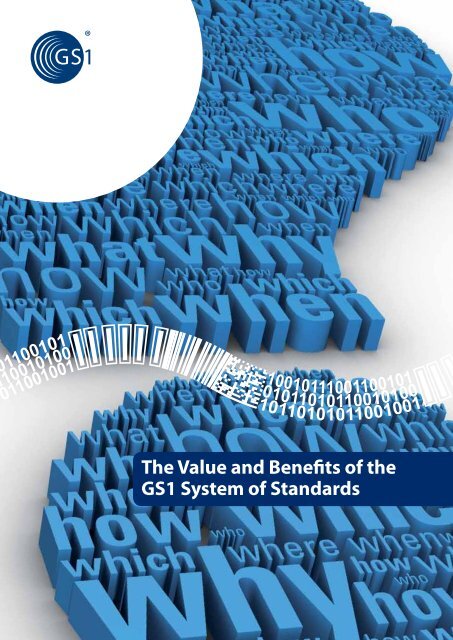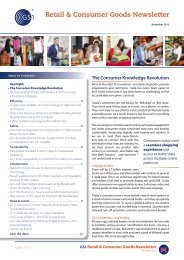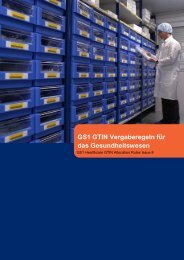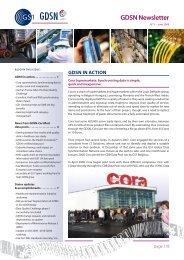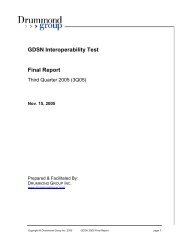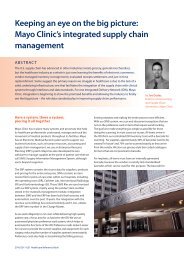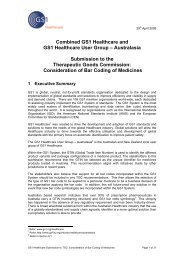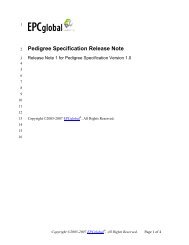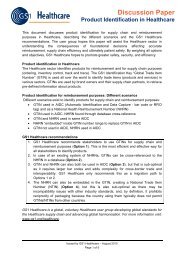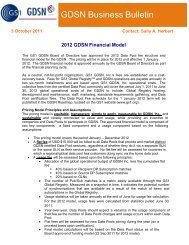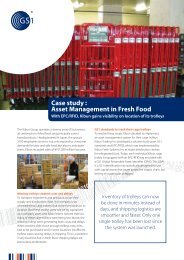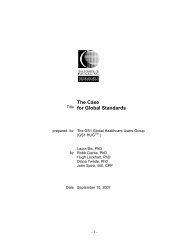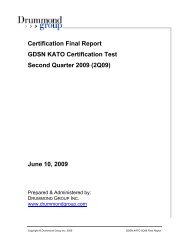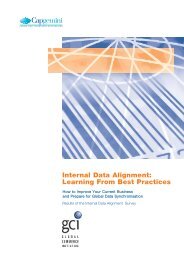The Value and Benefits of the GS1 System of Standards
The Value and Benefits of the GS1 System of Standards
The Value and Benefits of the GS1 System of Standards
You also want an ePaper? Increase the reach of your titles
YUMPU automatically turns print PDFs into web optimized ePapers that Google loves.
<strong>The</strong> <strong>Value</strong> <strong>and</strong> <strong>Benefits</strong> <strong>of</strong> <strong>the</strong><br />
<strong>GS1</strong> <strong>System</strong> <strong>of</strong> St<strong>and</strong>ards
<strong>GS1</strong> designs <strong>and</strong> manages a global system <strong>of</strong><br />
supply chain st<strong>and</strong>ards.<br />
For <strong>the</strong> last 30 years, <strong>GS1</strong> has been dedicated to <strong>the</strong><br />
design <strong>and</strong> implementation <strong>of</strong> global st<strong>and</strong>ards<br />
for use in <strong>the</strong> supply chain. <strong>GS1</strong> st<strong>and</strong>ards provide<br />
a framework that allows products, services, <strong>and</strong><br />
information about <strong>the</strong>m to move efficiently <strong>and</strong><br />
securely for <strong>the</strong> benefit <strong>of</strong> businesses <strong>and</strong> <strong>the</strong><br />
improvement <strong>of</strong> people’s lives, everyday, everywhere.<br />
Our st<strong>and</strong>ards ensure effective exchanges between<br />
companies, <strong>and</strong> act as basic guidelines that facilitate<br />
interoperability <strong>and</strong> provide structure to many<br />
industries.<br />
<strong>GS1</strong> st<strong>and</strong>ards bring toge<strong>the</strong>r companies representing<br />
all parts <strong>of</strong> <strong>the</strong> supply chain – manufacturers,<br />
distributors, retailers, hospitals, transporters, customs<br />
organisations, s<strong>of</strong>tware developers, local <strong>and</strong><br />
international regulatory authorities, <strong>and</strong> more.<br />
<strong>GS1</strong> st<strong>and</strong>ards are used by huge multinational chains<br />
<strong>and</strong> by small corner shops, by world-famous br<strong>and</strong>s<br />
<strong>and</strong> by individual craftsmen. <strong>The</strong>se companies, who<br />
may in fact have diverging business interests, work<br />
toge<strong>the</strong>r under our leadership to agree upon st<strong>and</strong>ards<br />
that make <strong>the</strong> supply chain faster, more efficient, less<br />
complex <strong>and</strong> less costly.<br />
Read more about <strong>GS1</strong> at www.gs1.org<br />
At <strong>GS1</strong>, our vision is a world where things <strong>and</strong> information about <strong>the</strong>m move efficiently <strong>and</strong> securely<br />
for <strong>the</strong> benefit <strong>of</strong> businesses <strong>and</strong> <strong>the</strong> improvement <strong>of</strong> peoples’ lives, everyday, everywhere.<br />
Our mission is to be <strong>the</strong> neutral leader enabling communities to develop <strong>and</strong> implement global<br />
st<strong>and</strong>ards providing <strong>the</strong> tools, trust <strong>and</strong> confidence needed to achieve our vision.
CONTENTS<br />
Introduction<br />
- <strong>The</strong> roles st<strong>and</strong>ards play<br />
- Why choose <strong>the</strong> <strong>GS1</strong> <strong>System</strong> <strong>of</strong> St<strong>and</strong>ards<br />
How <strong>the</strong> <strong>GS1</strong> <strong>System</strong> <strong>of</strong> St<strong>and</strong>ards works<br />
- Interoperable building blocks<br />
<strong>GS1</strong> Automatic Identification<br />
- <strong>GS1</strong> Identification Keys<br />
GTIN – Global Trade Item Number<br />
GLN – Global Location Number<br />
SSCC – Serial Shipping Container Code<br />
O<strong>the</strong>r <strong>GS1</strong> ID Keys<br />
- <strong>GS1</strong> Application Identifiers<br />
- <strong>GS1</strong> Data Carriers<br />
EAN/UPC barcodes<br />
ITF-14 barcodes<br />
<strong>GS1</strong>-128 barcodes<br />
<strong>GS1</strong> DataBar barcodes<br />
<strong>GS1</strong> DataMatrix barcodes<br />
EPC/RFID tags<br />
- <strong>The</strong> Electronic Product Code (EPC)<br />
<strong>GS1</strong> Communication St<strong>and</strong>ards<br />
- Master data sharing with GDSN<br />
- Transactional data with <strong>GS1</strong> eCom<br />
<strong>GS1</strong> EANCOM<br />
<strong>GS1</strong> XML<br />
- Visibility data with EPCIS<br />
How <strong>GS1</strong> St<strong>and</strong>ards are made<br />
<strong>The</strong> <strong>System</strong> you can trust<br />
3
St<strong>and</strong>ards play a variety <strong>of</strong> critical roles<br />
Perhaps you are an expert on retail supply<br />
chain st<strong>and</strong>ards; perhaps you are involved in deploying an<br />
automatic identification project in <strong>the</strong> healthcare sector;<br />
or a traceability programme in <strong>the</strong> field <strong>of</strong> transport <strong>and</strong><br />
logistics. Or perhaps you’re not so closely involved with<br />
that aspect <strong>of</strong> your business or your industry.<br />
But no matter whe<strong>the</strong>r you’re an expert or not, <strong>and</strong> no<br />
matter how much or how little time <strong>and</strong> attention you or<br />
your organisation gives to st<strong>and</strong>ards, you certainly should<br />
care about <strong>the</strong> value <strong>and</strong> <strong>the</strong> benefits that st<strong>and</strong>ards<br />
bring.<br />
Companies care<br />
about <strong>the</strong> value <strong>and</strong><br />
<strong>the</strong> benefits that<br />
st<strong>and</strong>ards bring.<br />
Indeed, well-designed supply chain st<strong>and</strong>ards play a very<br />
important role in day-to-day business operations: <strong>The</strong>y<br />
reduce complexity between <strong>and</strong> within organisations.<br />
<strong>The</strong>y make it easier to make <strong>the</strong> right decisions about<br />
purchasing hardware, s<strong>of</strong>tware <strong>and</strong> equipment; <strong>and</strong> <strong>the</strong>n<br />
<strong>the</strong>y reduce <strong>the</strong> costs <strong>of</strong> implementation, integration<br />
<strong>and</strong> maintenance. <strong>The</strong>y facilitate collaboration between<br />
trading partners in <strong>the</strong> supply chain, making it quicker<br />
<strong>and</strong> easier to identify items, share information (like order<br />
quantities, availability, or specific characteristics), order<br />
<strong>and</strong> receive parts or ingredients from suppliers, or ship<br />
goods to customers. <strong>The</strong>y help improve patient safety <strong>and</strong><br />
reduce medication errors. <strong>The</strong>y enable global traceability<br />
<strong>and</strong> au<strong>the</strong>ntication. <strong>The</strong>y improve efficiency.<br />
In short, well-designed st<strong>and</strong>ards allow<br />
organisations to focus on how to use information<br />
ra<strong>the</strong>r than how to get information.<br />
Well-designed st<strong>and</strong>ards are more important than ever<br />
before in <strong>the</strong> context <strong>of</strong> today’s challenging economy,<br />
because <strong>the</strong>y are <strong>the</strong> foundation for clear, underst<strong>and</strong>able<br />
exchanges that keep costs down for everyone by<br />
reducing complexity.<br />
St<strong>and</strong>ards are agreements that structure<br />
any activity or any industry. <strong>The</strong>y may be<br />
rules or guidelines that everyone applies<br />
in <strong>the</strong> same way. <strong>The</strong>y may be an agreedupon<br />
<strong>and</strong> uniform way <strong>of</strong> measuring, or<br />
describing, or classifying products or<br />
services.<br />
With proper st<strong>and</strong>ards, <strong>the</strong> logistics <strong>of</strong> international supply<br />
chains are more efficient, more sustainable, <strong>and</strong> more<br />
pr<strong>of</strong>itable.<br />
<strong>GS1</strong> creates <strong>and</strong> manages just such a proper <strong>and</strong> welldesigned<br />
system <strong>of</strong> st<strong>and</strong>ards for <strong>the</strong> global supply chain.
Why choose <strong>the</strong> <strong>GS1</strong> <strong>System</strong> <strong>of</strong> St<strong>and</strong>ards<br />
Some companies develop <strong>the</strong>ir own<br />
proprietary identification, classification <strong>and</strong> data capture<br />
systems. O<strong>the</strong>rs use st<strong>and</strong>ards that are only functional<br />
within <strong>the</strong> confines <strong>of</strong> one single industry sector, or one<br />
single country.<br />
<strong>The</strong> <strong>GS1</strong> <strong>System</strong> <strong>of</strong> St<strong>and</strong>ards is a much better choice,<br />
however, because it is global, robust, multi-sector, usergenerated,<br />
<strong>and</strong> scalable.<br />
Global<br />
No matter where in <strong>the</strong><br />
world your company<br />
– or its suppliers, or its<br />
customers – is based, <strong>GS1</strong><br />
st<strong>and</strong>ards will function<br />
perfectly <strong>the</strong>re. <strong>The</strong> <strong>GS1</strong><br />
<strong>System</strong> <strong>of</strong> St<strong>and</strong>ards is<br />
truly global.<br />
Robust<br />
Our st<strong>and</strong>ards have been purpose-built to be extremely<br />
robust. <strong>The</strong>y react <strong>and</strong> respond predictably, even in<br />
unpredictable situations. <strong>The</strong> <strong>GS1</strong> Identification Keys<br />
have a defined structure <strong>of</strong>ten including a “check digit”<br />
which helps prevent accidental key stroke errors; <strong>GS1</strong> Data<br />
Carriers are best-in-class with highly reliable first-time<br />
read rates; <strong>GS1</strong> Communication St<strong>and</strong>ards have benefited<br />
from multiple data accuracy improvements; <strong>and</strong> toge<strong>the</strong>r<br />
<strong>the</strong> <strong>GS1</strong> <strong>System</strong> is solid <strong>and</strong> scalable.<br />
Multi-sector<br />
<strong>GS1</strong> st<strong>and</strong>ards work within your organisation … <strong>and</strong><br />
outside <strong>of</strong> it too. But don’t just take our word for it:<br />
<strong>the</strong> <strong>GS1</strong> <strong>System</strong> <strong>of</strong> St<strong>and</strong>ards has been endorsed by<br />
a wide variety <strong>of</strong> industries. We enjoy strong working<br />
partnerships <strong>and</strong> alliances with a variety <strong>of</strong> organisations<br />
<strong>and</strong> trade associations, including Efficient Consumer<br />
Response (ECR), <strong>the</strong> Consumer Goods Forum, AIM Global<br />
(Association for Automatic Identification <strong>and</strong> Mobility),<br />
<strong>and</strong> <strong>the</strong> WCO (World Customs Organization). <strong>The</strong> global<br />
healthcare sector is widely adopting <strong>GS1</strong> st<strong>and</strong>ards, <strong>and</strong><br />
a number <strong>of</strong> national Ministries <strong>of</strong> Health has regulated<br />
<strong>the</strong>ir use. Similarly, a Memor<strong>and</strong>um <strong>of</strong> Underst<strong>and</strong>ing has<br />
been signed with <strong>the</strong> World Customs Organization, which<br />
recognises in <strong>GS1</strong> a true partner <strong>and</strong> ally in its efforts to<br />
protect borders. Fur<strong>the</strong>rmore, for many years, <strong>GS1</strong> <strong>and</strong><br />
<strong>GS1</strong> Member Organisations have been actively engaged<br />
in UN/CEFACT, <strong>the</strong> United Nations Centre for Trade<br />
Facilitation <strong>and</strong> Electronic Business; <strong>and</strong> <strong>GS1</strong> has also<br />
had a long <strong>and</strong> fruitful working relationship with ISO, <strong>the</strong><br />
International Organization for St<strong>and</strong>ardization.<br />
User-generated<br />
All <strong>GS1</strong> st<strong>and</strong>ards are built <strong>and</strong> maintained through <strong>the</strong><br />
<strong>GS1</strong> Global St<strong>and</strong>ards Management Process (GSMP),<br />
a worldwide collaborative forum. <strong>The</strong> GSMP is an<br />
open <strong>and</strong> transparent process which brings toge<strong>the</strong>r<br />
volunteers from all industries <strong>and</strong> from everywhere in<br />
<strong>the</strong> world to identify needs for st<strong>and</strong>ards, ga<strong>the</strong>r business<br />
requirements, document best practices, obtain consensus<br />
on solutions, <strong>and</strong> <strong>the</strong>n develop <strong>and</strong> implement <strong>the</strong><br />
resulting supply chain st<strong>and</strong>ards.<br />
Scalable<br />
Whe<strong>the</strong>r you are a small company or a large one, whe<strong>the</strong>r<br />
you have one single product or hundreds, <strong>the</strong> <strong>GS1</strong> <strong>System</strong><br />
<strong>of</strong> St<strong>and</strong>ards is perfectly suited to your needs. Indeed, if<br />
you are a small or specialised company, using <strong>the</strong> <strong>GS1</strong><br />
<strong>System</strong> is a particularly intelligent choice. Why? Because<br />
it’s eminently scalable. No matter what <strong>the</strong> future holds<br />
for your business – an expansion <strong>of</strong> your line <strong>of</strong> products<br />
or services, an extension into new geographies, an<br />
acquisition or a merger – with <strong>the</strong> <strong>GS1</strong> <strong>System</strong>, you are<br />
ready.<br />
<strong>The</strong> better choice<br />
For more than 30 years, <strong>GS1</strong>’s voluntary st<strong>and</strong>ards have<br />
been providing a framework that ensures effective<br />
exchanges between companies <strong>and</strong> act as basic<br />
guidelines that facilitate interoperability <strong>and</strong> provide<br />
structure to many industries. And though <strong>the</strong>y were<br />
originally created by manufacturers <strong>and</strong> retailers to<br />
improve <strong>the</strong> efficiency <strong>of</strong> <strong>the</strong> distribution <strong>of</strong> food <strong>and</strong><br />
consumer goods to supermarkets, <strong>GS1</strong> st<strong>and</strong>ards are used<br />
today by more than a million companies in dozens <strong>of</strong><br />
sectors including healthcare, transportation <strong>and</strong> logistics,<br />
chemicals, high tech – <strong>and</strong> still, <strong>of</strong> course, <strong>the</strong> retail supply<br />
chain.<br />
5
How <strong>the</strong> <strong>GS1</strong> <strong>System</strong> <strong>of</strong> St<strong>and</strong>ards works<br />
<strong>The</strong> <strong>GS1</strong> <strong>System</strong> <strong>of</strong> St<strong>and</strong>ards is a flexible<br />
architecture that ensures maximum efficiency. It is built<br />
around <strong>and</strong> upon two main elements: <strong>GS1</strong> Automatic<br />
Identification St<strong>and</strong>ards <strong>and</strong> <strong>GS1</strong> Communication<br />
St<strong>and</strong>ards.<br />
<strong>GS1</strong> Automatic Identification St<strong>and</strong>ards are <strong>the</strong>mselves<br />
composed <strong>of</strong> several elements: <strong>GS1</strong> Identification (ID)<br />
Keys <strong>and</strong> Application Identifiers, <strong>GS1</strong> Data Carriers <strong>and</strong> <strong>the</strong><br />
EPC Identifier.<br />
<strong>GS1</strong> ID Keys <strong>and</strong> Application Identifiers are specially<br />
designed to work with <strong>the</strong> <strong>GS1</strong> Data Carriers: <strong>GS1</strong><br />
BarCodes or EPC/RFID tags. <strong>The</strong> EPC, which incorporates<br />
<strong>GS1</strong> Identification Keys as well as Keys from o<strong>the</strong>r systems,<br />
is <strong>the</strong> foundation for encoding an EPC/RFID tag.<br />
<strong>GS1</strong> Communication St<strong>and</strong>ards deal with transactional<br />
data, which is data that acknowledges <strong>the</strong> completion<br />
<strong>of</strong> a business transaction such as one supported by <strong>GS1</strong><br />
eCom st<strong>and</strong>ards; <strong>the</strong>y deal with visibility data, which is<br />
data that logs <strong>the</strong> occurrence <strong>of</strong> a physical event (item<br />
loaded onto ship, item arrived in port, item inspected at<br />
customs…) in EPCIS; <strong>and</strong> <strong>the</strong>y enable master data sharing<br />
between trading partners in <strong>the</strong> supply chain using <strong>the</strong><br />
Global Data Synchronisation Network (GDSN). Billions <strong>of</strong><br />
times each day, <strong>the</strong> <strong>GS1</strong> <strong>System</strong> <strong>of</strong> St<strong>and</strong>ards connects<br />
physical things such as products, locations, logistics units,<br />
<strong>and</strong> assets with information about those things supplied<br />
by <strong>GS1</strong> Communication St<strong>and</strong>ards.<br />
<strong>The</strong> <strong>GS1</strong> <strong>System</strong><br />
Identification Keys<br />
Automatic Data Capture<br />
Electronic Data Interchange<br />
<strong>GS1</strong> Communiction St<strong>and</strong>ards<br />
<strong>GS1</strong> XML<br />
EPCglobal<br />
Network<br />
WebEDI<br />
GDSN<br />
EANCOM<br />
ONS<br />
EPCIS<br />
etc...<br />
GTIN<br />
SSCC<br />
GRAI<br />
GIAI<br />
GLN<br />
<strong>GS1</strong> keys<br />
GTIN<br />
SSCC<br />
GRAI<br />
GIAI<br />
GLN<br />
<strong>GS1</strong> Data Carriers<br />
<strong>GS1</strong> DataBar<br />
<strong>GS1</strong>-128<br />
<strong>GS1</strong> DataMatrix<br />
EAN/UPC<br />
ITF-14<br />
EPC GEN2 tag<br />
<strong>GS1</strong> keys<br />
GTIN<br />
SSCC<br />
GRAI<br />
GIAI<br />
GLN<br />
<strong>GS1</strong> Data Carriers<br />
<strong>GS1</strong> DataBar<br />
<strong>GS1</strong>-128<br />
<strong>GS1</strong> DataMatrix<br />
EAN/UPC<br />
ITF-14<br />
EPC GEN2 tag<br />
<strong>GS1</strong> keys
Identify<br />
Global Location<br />
Number<br />
GLN<br />
Global Location<br />
Number<br />
GLN<br />
Global Location<br />
Number<br />
GLN<br />
Manufacturer Item Case Pallet Transport Distributor Transport Pallet Case Item Store Customer<br />
GTIN<br />
Global Trade<br />
item number<br />
SSCC<br />
Serial shipping<br />
container code<br />
GTIN<br />
Global Trade<br />
item number<br />
BAR CODES<br />
Capture<br />
<strong>GS1</strong> <strong>System</strong> data carriers<br />
EPC/RFID<br />
Share<br />
Item Data<br />
Price <strong>and</strong><br />
Promotion Data<br />
Shipping<br />
Notice<br />
Invoice<br />
Product<br />
Recall<br />
Request For<br />
Quotation<br />
Planning<br />
Schedule<br />
Purchase<br />
Order<br />
7
Interoperable building blocks<br />
<strong>The</strong> <strong>GS1</strong> <strong>System</strong> has been designed to ensure<br />
that all <strong>of</strong> <strong>the</strong> elements are compatible <strong>and</strong> interoperable<br />
with each o<strong>the</strong>r.<br />
As a result, <strong>the</strong>y can be deployed in ways that meet very<br />
specific customer needs – <strong>and</strong> at <strong>the</strong> same time are<br />
compatible with future process changes in <strong>the</strong> supply<br />
chain, or new additions to <strong>the</strong> <strong>GS1</strong> St<strong>and</strong>ards family.<br />
Retail Point-<strong>of</strong>-Sale<br />
Procurement<br />
Healthcare<br />
GTIN + EAN/UPC + <strong>GS1</strong> DataBar<br />
+ EPC/RFID tags + GDSN<br />
<strong>GS1</strong> eCOM + GLN + GTIN<br />
+ <strong>GS1</strong> DATA CARRIERS + GDSN<br />
S-GTIN + GTIN + <strong>GS1</strong> DataMatrix<br />
+ EPC/RFID tags + GDSN<br />
GDSN<br />
GDSN<br />
<strong>GS1</strong> eCom<br />
GDSN<br />
EAN/UPC<br />
<strong>GS1</strong> DataBar<br />
EPC/RFID<br />
<strong>GS1</strong> Data<br />
Carriers<br />
EPC/RFID<br />
tags<br />
<strong>GS1</strong><br />
DataMatrix<br />
GTIN<br />
GTIN<br />
GLN<br />
S-GTIN<br />
GTIN<br />
Visibility<br />
S-GTIN + GRAI + GIAI + GSRN<br />
+ GDTI + EPCIS + EAN/UPC<br />
+ <strong>GS1</strong>-128 + EPC/RFID tags<br />
Transport & Logistics<br />
SSCC + GINC + GSIN + <strong>GS1</strong>-128<br />
+ EPC/RFID tags + <strong>GS1</strong> eCOM<br />
Food Service<br />
GTIN + GRAI + GLN + EAN/UPC<br />
+ <strong>GS1</strong>-128 + EPC/RFID tags + GDSN<br />
GIAI<br />
EAN/UPC<br />
EPCIS<br />
GSRN<br />
<strong>GS1</strong>-128<br />
GDTI<br />
EPC/RFID<br />
tags<br />
<strong>GS1</strong>-128<br />
<strong>GS1</strong> eCOM<br />
EPC/RFID<br />
tags<br />
SSCC GINC GSIN<br />
EAN/UPC<br />
GDSN<br />
<strong>GS1</strong>-128<br />
EPC/RFID<br />
tags<br />
S-GTIN GRAI GLN<br />
S-GTIN<br />
GRAI<br />
Traceability<br />
GDSN<br />
<strong>GS1</strong> ID KEYS + <strong>GS1</strong> DATA CARRIERS + GDSN<br />
<strong>GS1</strong> Data<br />
Carriers<br />
<strong>GS1</strong> ID KEYS<br />
<strong>The</strong> <strong>GS1</strong> <strong>System</strong><br />
When combined in different ways, <strong>the</strong> individual building blocks<br />
<strong>of</strong> <strong>the</strong> <strong>GS1</strong> <strong>System</strong> present a variety <strong>of</strong> uses <strong>and</strong> benefits.<br />
GDSN<br />
<strong>GS1</strong> eCom<br />
<strong>GS1</strong> XML<br />
EPCIS<br />
EAN/UPC<br />
<strong>GS1</strong> DataBar<br />
ITF<br />
<strong>GS1</strong>-128<br />
<strong>GS1</strong><br />
DataMatrix<br />
EPC/RFID<br />
tags<br />
GTIN GLN SSCC GRAI GIAI<br />
GDTI GSRN GSIN GINC
<strong>GS1</strong> Automatic<br />
Identification<br />
<strong>GS1</strong> Identification Keys &<br />
Application Identifiers<br />
<strong>GS1</strong> Data Carriers<br />
<strong>The</strong> Electronic Product Code (EPC)<br />
9
<strong>GS1</strong> Identification Keys<br />
<strong>GS1</strong> Identification Keys are used to name <strong>and</strong><br />
distinguish any object, thing or location, so interested<br />
parties can get information or business messages related<br />
to <strong>the</strong>m.<br />
<strong>The</strong> main <strong>GS1</strong> ID Keys are:<br />
GTIN – Global Trade Item Number<br />
Global Trade Item Number (GTIN-13 Structure)<br />
<strong>GS1</strong> Company Prefix<br />
Item Reference<br />
Check Digit<br />
N 1 N 2 N 3 N 4 N 5 N 6 N 7 N 8 N 9 N 10 N 11 N 12 N 13<br />
GLN – Global Location Number<br />
Global Location Number Structure<br />
<strong>GS1</strong> Company Prefix<br />
Location Reference<br />
Check Digit<br />
N 1 N 2 N 3 N 4 N 5 N 6 N 7 N 8 N 9 N 10 N 11 N 12 N 13<br />
SSCC – Serial Shipping Container Code<br />
SSCC (Serial Shipping Container Code)<br />
Extension Digit<br />
<strong>GS1</strong> Company Prefix<br />
Serial Reference<br />
Check Digit<br />
N 1 N 2 N 3 N 4 N 5 N 6 N 7 N 8 N 9 N 10 N 11 N 12 N 13 N 14 N 15 N 16 N 17<br />
N 18<br />
<strong>The</strong> o<strong>the</strong>r <strong>GS1</strong> ID Keys are:<br />
GRAI – Global Returnable Asset Identifier<br />
GIAI – Global Individual Asset Identifier<br />
GSRN – Global Service Relation Number<br />
GDTI – Global Document Type Identifier<br />
GSIN – Global Shipment Identification Number<br />
GINC – Global Identification Number for Consignment
GTIN - Global Trade Item Number<br />
<strong>The</strong> Global Trade Item Number, or GTIN, is one<br />
<strong>of</strong> <strong>the</strong> main building blocks <strong>of</strong> <strong>the</strong> <strong>GS1</strong> <strong>System</strong>.<br />
GTIN is used to uniquely identify trade items, which are<br />
products <strong>and</strong> services that are priced, ordered or invoiced<br />
at any point in <strong>the</strong> supply chain, whe<strong>the</strong>r at <strong>the</strong> checkout,<br />
in a warehouse, in an electronic catalogue or elsewhere.<br />
Each trade item that is different from ano<strong>the</strong>r is allocated<br />
its own separate GTIN.<br />
<strong>The</strong> GTIN is used to<br />
uniquely identify<br />
trade items.<br />
Each trade item<br />
that is different<br />
from ano<strong>the</strong>r is<br />
allocated its own<br />
separate GTIN.<br />
to differentiate individual tyres so that <strong>the</strong>y can be tracked<br />
through <strong>the</strong>ir lifecycle. Serialised GTINs, for example,<br />
enable tyres on commercial lorries to be maintained at<br />
proper intervals <strong>and</strong> withdrawn from use when <strong>the</strong>y have<br />
been in circulation a certain amount <strong>of</strong> time.<br />
a b c d<br />
<strong>The</strong>ir main function is to provide a way to uniquely<br />
identify any item so it can be looked up in a database – for<br />
example to get its price, record its sale, confirm its delivery<br />
or identify its order – <strong>and</strong> this, at any point during <strong>the</strong><br />
supply chain <strong>and</strong> from any place in <strong>the</strong> world.<br />
GTINs provide accuracy, speed <strong>and</strong> efficiencies to millions<br />
<strong>of</strong> companies around <strong>the</strong> world, in all areas <strong>of</strong> modern<br />
business.<br />
<strong>The</strong>re is also a serialised form <strong>of</strong> <strong>the</strong> GTIN: a Serialised<br />
GTIN identifies <strong>the</strong> specific instance <strong>of</strong> a trade item. For<br />
example, serialised GTINs are used in <strong>the</strong> healthcare sector<br />
to distinguish individual implants which are o<strong>the</strong>rwise <strong>of</strong><br />
<strong>the</strong> same br<strong>and</strong> <strong>and</strong> characteristics; or in tyre production<br />
<strong>The</strong> GTIN is <strong>the</strong> world’s most widely used identification<br />
system with global uniqueness guaranteed by <strong>the</strong><br />
structure:<br />
a. <strong>GS1</strong> Prefix: Provides a number capacity to each <strong>GS1</strong><br />
Member Organisation <strong>and</strong> enables local administration<br />
b. Company number: Combined with <strong>the</strong> <strong>GS1</strong> Prefix this<br />
forms <strong>the</strong> <strong>GS1</strong> Company Prefix allowing companies to<br />
allocate GTIN <strong>and</strong> o<strong>the</strong>r <strong>GS1</strong> ID Keys<br />
c. Item Reference: Allocated by <strong>the</strong> company with each<br />
different product receiving a different number<br />
d. Check Digit: Calculated from all o<strong>the</strong>r digits to<br />
provide extra security<br />
<strong>The</strong> GTIN is supported, promoted <strong>and</strong> obtainable from<br />
any <strong>GS1</strong> Member Organisation anywhere in <strong>the</strong> world.<br />
11
GLN - Global Location Number<br />
<strong>The</strong> Global Location Number, or GLN, is <strong>the</strong> <strong>GS1</strong><br />
ID Key used to identify locations <strong>and</strong> legal entities.<br />
Locations can be a physical place such as a warehouse,<br />
a storage cabinet or even a specific shelf within a store;<br />
<strong>the</strong>y can be a legal entity such as a company, or division<br />
<strong>of</strong> a company; or <strong>the</strong>y can be a function that takes place<br />
within a legal entity, such as <strong>the</strong> accounting department<br />
<strong>of</strong> a company or <strong>the</strong> paediatrics ward <strong>of</strong> a hospital.<br />
<strong>The</strong> GLN identifies<br />
any location<br />
anywhere in<br />
<strong>the</strong> world in a<br />
unique way.<br />
Being able to identify locations with a unique number<br />
is vital to many business processes; GLNs are also<br />
<strong>the</strong> essential building block for a variety <strong>of</strong> EPC/RFID<br />
applications built around event capture.<br />
Using a GLN ra<strong>the</strong>r than a proprietary internal numbering<br />
system for locations gives a company significant<br />
advantages, because it provides a st<strong>and</strong>ardised way to<br />
uniquely identify locations important to <strong>the</strong> supply chain.<br />
a b c d<br />
<strong>The</strong> GLN is a multi-sector global solution for identifying<br />
locations at whatever level <strong>of</strong> granularity is needed.<br />
This ISO-compliant identifier removes <strong>the</strong> need for<br />
complicated proprietary location numbering systems.<br />
Its global uniqueness is guaranteed by its structure:<br />
a. <strong>GS1</strong> Application Identifier: provides <strong>the</strong> meaning <strong>of</strong><br />
<strong>the</strong> data field which follows, allowing <strong>the</strong> same <strong>GS1</strong><br />
Data Carrier to encode multiple data<br />
b. <strong>GS1</strong> Company Prefix: allocated by <strong>GS1</strong> Member<br />
Organisations to member companies enabling <strong>the</strong>m to<br />
allocate GLNs<br />
c. Location Reference: allocated by <strong>the</strong> location owner<br />
with each different location receiving a different<br />
number<br />
d. Check Digit: calculated from all o<strong>the</strong>r digits to provide<br />
extra security<br />
<strong>The</strong> GLN is supported, promoted <strong>and</strong> obtainable from<br />
any <strong>GS1</strong> Member Organisation anywhere in <strong>the</strong> world.
SSCC – Serial Shipping Container Code<br />
<strong>The</strong> Serial Shipping Container Code (SSCC) is<br />
<strong>the</strong> <strong>GS1</strong> ID Key used to identify individual logistic units.<br />
A logistic unit can be any combination <strong>of</strong> units put<br />
toge<strong>the</strong>r in a carton, in a case, on a pallet or on a truck,<br />
where <strong>the</strong> specific unit load needs to be managed<br />
through <strong>the</strong> supply chain. <strong>The</strong> SSCC enables a unit to<br />
be tracked individually, providing benefits for order <strong>and</strong><br />
delivery tracking <strong>and</strong> automated goods-receiving.<br />
<strong>The</strong> serial reference component <strong>of</strong> <strong>the</strong> SSCC provides<br />
virtually unlimited number capacity, simplifying number<br />
allocation <strong>and</strong> guaranteeing unique identification.<br />
<strong>The</strong> SSCC identifies<br />
individual logistic<br />
units, like cartons,<br />
crates, or pallets.<br />
As <strong>the</strong> SSCC provides a unique number, it can also be<br />
utilised as a look-up number to provide not only detailed<br />
information regarding <strong>the</strong> contents <strong>of</strong> <strong>the</strong> load, but<br />
also as part <strong>of</strong> an Advanced Shipping Notice (ASN) or<br />
Despatch Advice process. Fur<strong>the</strong>rmore, with an SSCC,<br />
a company can reliably look up details about complex<br />
loads, which saves <strong>the</strong> sender from having to encode long<br />
consignment information on individual logistic unit labels.<br />
a b c d e<br />
<strong>The</strong> SSCC links barcode or EPC/RFID tag information<br />
to electronic communications about <strong>the</strong> logistic unit.<br />
SSCCs are ISO licence plate-compliant (ISO/IEC 15459)<br />
for tracking <strong>and</strong> tracing logistic units. Its structure:<br />
a. <strong>GS1</strong> Application Identifier: provides <strong>the</strong> meaning <strong>of</strong><br />
<strong>the</strong> data field which follows, allowing <strong>the</strong> same <strong>GS1</strong><br />
Data Carrier to encode multiple data<br />
b. Extension Digit: allocated by <strong>the</strong> user to increase<br />
capacity<br />
c. <strong>GS1</strong> Company Prefix: Allocated by <strong>GS1</strong> Member<br />
Organisations to member companies enabling <strong>the</strong>m to<br />
allocate SSCCs<br />
d. Serial Reference: Allocated by <strong>the</strong> creator <strong>of</strong> <strong>the</strong><br />
logistic unit with each logistic unit receiving a different<br />
number<br />
e. Check Digit: Calculated from all o<strong>the</strong>r digits to<br />
provide extra security<br />
<strong>The</strong> SSCC is supported, promoted <strong>and</strong> obtainable from<br />
any <strong>GS1</strong> Member Organisation anywhere in <strong>the</strong> world.<br />
13
O<strong>the</strong>r <strong>GS1</strong> ID Keys<br />
such as re-usable transport equipment like trays, crates,<br />
pallets or beer kegs that are used <strong>and</strong> <strong>the</strong>n returned to<br />
be used again. <strong>The</strong> GRAI can be used simply for asset<br />
identification <strong>and</strong> tracking purposes, or it can be part <strong>of</strong><br />
a hiring or rental system where two or more companies<br />
collaborate, as it allows enterprises to scan assets into <strong>and</strong><br />
out <strong>of</strong> <strong>the</strong>ir businesses.<br />
GSRN – Global Service Relation Number<br />
<strong>The</strong> Global Service Relation Number is <strong>the</strong> <strong>GS1</strong> ID<br />
Key used to identify a service relationship between a<br />
business <strong>and</strong> a client, such as club membership, loyalty<br />
programmes, or a patient in a hospital.<br />
GRAI – Global Returnable Asset Identifier<br />
<strong>The</strong> Global Returnable Asset Identifier (GRAI) is one <strong>of</strong><br />
<strong>the</strong> two <strong>GS1</strong> ID Keys for asset identification. As its name<br />
indicates, <strong>the</strong> GRAI is used to identify returnable assets<br />
GIAI – Global Individual Asset Identifier<br />
<strong>The</strong> Global Individual Asset Identifier (GIAI) is <strong>the</strong> second<br />
<strong>of</strong> two <strong>GS1</strong> ID Keys for asset identification. GIAIs are used<br />
to identify fixed assets <strong>of</strong> any value within a company<br />
that need to be identified uniquely, such as a computer,<br />
a desk, a vehicle or a component part. Having a unique<br />
identifier for <strong>the</strong>ir assets allows a business to identify, track<br />
<strong>and</strong> manage <strong>the</strong>m across <strong>the</strong>ir entire life. <strong>The</strong>y provide<br />
a quick way to be able to look up an asset in a database<br />
so its use, location or state can recorded, for example for<br />
stock reconciliation, to update a maintenance record, to<br />
register a s<strong>of</strong>tware upgrade or to assign an asset to a user<br />
or location.
GSIN – Global Shipment Identification Number<br />
<strong>The</strong> Global Shipment Identification Number (bill <strong>of</strong> lading)<br />
is a number assigned by a seller (sender) <strong>of</strong> <strong>the</strong> goods. It<br />
provides a globally unique number that identifies a logical<br />
grouping <strong>of</strong> physical units for <strong>the</strong> purpose <strong>of</strong> a transport<br />
shipment.<br />
GDTI – Global Document Type Identifier<br />
<strong>The</strong> Global Document Type Identifier (GDTI) is <strong>the</strong> <strong>GS1</strong> ID<br />
Key to identify a document by type. <strong>The</strong> term “document”<br />
here is applied broadly to cover any <strong>of</strong>ficial or private<br />
papers that infer a right (e.g., a pro<strong>of</strong> <strong>of</strong> ownership) or<br />
an obligation (e.g., call for military service) upon <strong>the</strong><br />
bearer. O<strong>the</strong>r examples <strong>of</strong> <strong>the</strong> kinds <strong>of</strong> documents that<br />
could have a GDTI are tax dem<strong>and</strong>s, pro<strong>of</strong> <strong>of</strong> shipment<br />
forms, insurance policies, internal invoices, nationalised<br />
or st<strong>and</strong>ardised exams, <strong>and</strong> passports. A company<br />
or business will issue a GDTI where it is important to<br />
maintain a record <strong>of</strong> <strong>the</strong> document; <strong>the</strong> GDTI will provide<br />
a link to <strong>the</strong> database that holds <strong>the</strong> ‘master’ copy <strong>of</strong> <strong>the</strong><br />
document.<br />
GINC – Global Identification Number for<br />
Consignment<br />
<strong>The</strong> Global Identification Number for Consignment<br />
identifies a logical grouping <strong>of</strong> goods (one or more<br />
physical entities) that has been consigned to a freight<br />
forwarder or carrier <strong>and</strong> is intended to be transported as<br />
a whole.<br />
15
<strong>GS1</strong> Application Identifiers<br />
<strong>The</strong> <strong>GS1</strong> ID Keys are complemented by <strong>the</strong> <strong>GS1</strong><br />
Application Identifiers (or <strong>GS1</strong> AIs).<br />
<strong>GS1</strong> AIs act like a code list <strong>of</strong> generic <strong>and</strong> simple data<br />
fields for use in multi-sector <strong>and</strong> international supply<br />
chain applications. Each <strong>GS1</strong> AI consists <strong>of</strong> two or more<br />
digits <strong>and</strong> provides <strong>the</strong> definition, format <strong>and</strong> structure <strong>of</strong><br />
<strong>the</strong> data field encoded in a <strong>GS1</strong> Data Carrier. For example,<br />
a <strong>GS1</strong> AI exists for each <strong>GS1</strong> ID Key, allowing it to be<br />
encoded in <strong>GS1</strong> BarCodes or EPC/RFID tags.<br />
<strong>GS1</strong> AIs, <strong>and</strong> <strong>the</strong> associated application guidelines,<br />
have been designed for international <strong>and</strong> multi-sector<br />
purposes. <strong>The</strong> AIs allow multiple data to be encoded in<br />
a single <strong>GS1</strong> Data Carrier, thus improving read rates <strong>and</strong><br />
reducing print <strong>and</strong> production costs.<br />
Supplementary data is always associated with a <strong>GS1</strong><br />
ID Key <strong>and</strong>, while <strong>the</strong> intention is that <strong>the</strong> <strong>GS1</strong> ID Key is<br />
used to find information about <strong>the</strong> identified object in<br />
a database, <strong>GS1</strong> AIs exist for supplementary data that<br />
cannot be looked up in a database by reference to <strong>the</strong><br />
<strong>GS1</strong> ID key. This could happen if data is needed when<br />
connection to a database is not available; or when a<br />
batch number, expiration date or individual instance <strong>of</strong><br />
<strong>the</strong> object is required in barcode or EPC/RFID tag form.<br />
For example, <strong>the</strong> SSCC provides a unique reference<br />
number that can be used as <strong>the</strong> key to access all relevant<br />
information regarding <strong>the</strong> logistic unit in computer files.<br />
However, supplementary data relating to <strong>the</strong> logistic unit<br />
(e.g., ship-to information, logistic weights, et cetera) is also<br />
available as st<strong>and</strong>ardised supplementary data because<br />
access to this data might be needed when <strong>the</strong> goods are<br />
in transit <strong>and</strong> connection to a network is impracticable.<br />
<strong>GS1</strong> AIs present<br />
a st<strong>and</strong>ardised<br />
way to encode<br />
information in a<br />
single <strong>GS1</strong> Data<br />
Carrier.
<strong>GS1</strong> Data Carriers<br />
<strong>GS1</strong> has an entire portfolio <strong>of</strong> Data Carriers:<br />
different kinds <strong>of</strong> media that can hold <strong>GS1</strong> ID Keys <strong>and</strong><br />
attribute data. <strong>The</strong> same content can, in fact, be encoded<br />
onto different kinds <strong>of</strong> carriers, depending on what use<br />
will be made <strong>of</strong> it.<br />
ITF-14<br />
ITF-14 barcodes only encode GTINs. Because <strong>the</strong>y cannot<br />
be used to identify items that will cross a point <strong>of</strong> sale,<br />
<strong>the</strong>y are usually used for trade items where printing<br />
directly onto corrugated cartons is required.<br />
EAN/UPC BarCodes<br />
If a company wants to put a barcode on a trade item that<br />
can be scanned at any retail point <strong>of</strong> sale anywhere in <strong>the</strong><br />
world, <strong>the</strong>y need an EAN/UPC barcode.<br />
<strong>The</strong> <strong>GS1</strong> EAN/UPC barcode is <strong>the</strong> longest-established <strong>and</strong><br />
most widely used <strong>GS1</strong> Data Carrier. It is an indispensable<br />
product-marking method that is found on virtually every<br />
consumer product in <strong>the</strong> world. That little “beep” that<br />
people associate with <strong>the</strong> checkout <strong>of</strong> a supermarket is a<br />
laser scanning device reading <strong>the</strong> information encoded in<br />
an EAN/UPC barcode.<br />
<strong>The</strong>re are four primary EAN/UPC barcode types, <strong>and</strong> all are<br />
linear symbologies.<br />
• EAN-13 which encodes GTIN-13<br />
• UPC-A which encodes GTIN-12<br />
• EAN-8 which encodes GTIN-8<br />
• UPC-E which encodes a special “zero-suppressed”<br />
GTIN-12<br />
EAN/UPC does not encode any o<strong>the</strong>r <strong>GS1</strong> ID Key or any<br />
o<strong>the</strong>r <strong>GS1</strong> Application Identifier.<br />
<strong>The</strong>re are two supplementary EAN/UPC barcodes called<br />
<strong>the</strong> 2-digit <strong>and</strong> 5-digit add-on codes whose use is limited<br />
almost exclusively to books <strong>and</strong> periodicals.<br />
Besides its global ubiquity, <strong>the</strong> o<strong>the</strong>r great advantage<br />
<strong>of</strong> <strong>the</strong> EAN/UPC barcode is its omnidirectional scanning<br />
capability: an EAN/UPC barcode can be passed in front<br />
<strong>of</strong> a bar code reader at a point <strong>of</strong> sale right-side-up or<br />
upside-down, <strong>and</strong> it will still “beep” properly. This makes it<br />
a quick <strong>and</strong> efficient data carrier for high-volume scanning<br />
situations like supermarket cash registers.<br />
EAN-13<br />
UPC<br />
ITF-14<br />
1 9 3 12345 67890 4<br />
17
<strong>GS1</strong>-128<br />
When it comes to logistics, <strong>the</strong> <strong>GS1</strong>-128 Data Carrier is<br />
<strong>the</strong> gold st<strong>and</strong>ard. <strong>GS1</strong>-128 barcodes can carry all <strong>GS1</strong> ID<br />
Keys, as well as variable information like serial numbers,<br />
expiration dates dates, <strong>and</strong> measures.<br />
It is a linear symbology, with <strong>the</strong> advantage <strong>of</strong> being more<br />
compressed than o<strong>the</strong>r linear technologies.<br />
<strong>GS1</strong>-128 cannot be used to identify items crossing a retail<br />
point <strong>of</strong> sale; instead, its main role is in <strong>the</strong> transport <strong>and</strong><br />
logistics sector <strong>and</strong> <strong>the</strong> healthcare sector. <strong>The</strong> <strong>GS1</strong>-128<br />
bar code has taken on considerably greater importance<br />
in recent years, owing to <strong>the</strong> increasing requirements <strong>of</strong><br />
more stringent product traceability: indeed, a transport<br />
label with a <strong>GS1</strong>-128 barcode on it is <strong>the</strong> centrepiece <strong>of</strong><br />
any global st<strong>and</strong>ards-based tracking <strong>and</strong> tracing system.<br />
<strong>GS1</strong>-128 is very flexibly configurable, making it quite<br />
adaptable to a wide variety <strong>of</strong> needs <strong>and</strong> use cases.<br />
It can be read with a variety <strong>of</strong> commercially available<br />
laser scanners.<br />
<strong>GS1</strong>-128
<strong>GS1</strong> DataBar<br />
<strong>GS1</strong> DataBar symbols can carry more information <strong>and</strong><br />
identify smaller items than EAN/UPC barcodes can <strong>and</strong><br />
can be also scanned at retail point <strong>of</strong> sale. As a result, <strong>GS1</strong><br />
DataBar enables GTIN identification for fresh variablemeasure<br />
<strong>and</strong> hard-to-mark products like loose fruit <strong>and</strong><br />
vegetables, jewellery <strong>and</strong> cosmetics.<br />
Additionally, <strong>GS1</strong> DataBar can carry <strong>GS1</strong> Application<br />
Identifiers such as serial numbers, lot numbers, <strong>and</strong><br />
expiration dates, creating solutions to support product<br />
au<strong>the</strong>ntication <strong>and</strong> traceability for fresh food products<br />
<strong>and</strong> couponing.<br />
<strong>GS1</strong> DataBar symbols were endorsed <strong>and</strong> adopted by <strong>GS1</strong><br />
after a compelling business case review by a global task<br />
force composed <strong>of</strong> retailers, fast-moving consumer goods<br />
manufacturers, pharmaceutical companies, <strong>GS1</strong> Member<br />
Organisations, <strong>and</strong> trade associations.<br />
<strong>The</strong> decision <strong>of</strong> whe<strong>the</strong>r to use <strong>GS1</strong> DataBar symbols or<br />
not will be left to <strong>the</strong> br<strong>and</strong> owner (<strong>the</strong> party responsible<br />
for specifying package design), as it is not obligatory to<br />
replace EAN/UPC barcodes where <strong>the</strong>y work today. <strong>The</strong><br />
date when <strong>GS1</strong> DataBar can be used openly is set for 2014<br />
at a global level, but earlier dates are being established on<br />
a country-by-country basis for specific applications (e.g.,<br />
coupons in <strong>the</strong> USA in 2011, loose produce rolling out<br />
2010 to 2014 in different markets).<br />
<strong>GS1</strong> DataBar OmniStacked<br />
Mainly used for individual marking <strong>of</strong> loose produce<br />
<strong>GS1</strong> DataBar Exp<strong>and</strong>ed Stacked<br />
Mainly used for h<strong>and</strong>ling coupons <strong>and</strong> for marking variable measure<br />
trade items, e.g. meat, cheese,…<br />
19
<strong>GS1</strong> DataMatrix<br />
Unlike <strong>the</strong> o<strong>the</strong>r <strong>GS1</strong> symbologies, <strong>GS1</strong> DataMatrix is<br />
a two-dimensional symbology that allows a wealth <strong>of</strong><br />
information to be encoded in a very compact space.<br />
However, it is not intended to be used at high volume<br />
“omni-directional” retail point-<strong>of</strong>-sale environments<br />
like supermarkets, because it is only compatible with<br />
applications whose reading systems use camera-based<br />
scanners.<br />
A particularly noteworthy feature <strong>of</strong> <strong>the</strong> <strong>GS1</strong> DataMatrix is<br />
that it can be used to apply markings directly to products,<br />
components, or individual parts. In such cases, <strong>the</strong> code<br />
is etched or laser-engraved directly onto <strong>the</strong> surface <strong>of</strong><br />
an item, making it indelible, even under harsh operating<br />
conditions. For example, a <strong>GS1</strong> DataMatrix engraved<br />
in this way can be used in <strong>the</strong> presence <strong>of</strong> grease in<br />
industrial applications or for items that are exposed to <strong>the</strong><br />
elements. This makes <strong>the</strong> <strong>GS1</strong> DataMatrix quite suitable for<br />
applications whose conditions do not allow for <strong>the</strong> use <strong>of</strong><br />
conventional barcodes.<br />
<strong>GS1</strong> DataMatrix is gaining popularity in <strong>the</strong> healthcare<br />
sector, as it meets many needs <strong>and</strong> opens up many<br />
opportunities to improve patient safety. For example,<br />
because it can carry <strong>GS1</strong> Application Identifiers, batch<br />
<strong>and</strong> serial numbers <strong>and</strong> expiration dates can be encoded<br />
onto medical products. Moreover, due to its compact<br />
size, a <strong>GS1</strong> DataMatrix symbol can fit onto just about any<br />
medical device. In <strong>the</strong> past, individual surgical instruments<br />
could not be labelled automatically. However a <strong>GS1</strong><br />
DataMatrix can be marked directly onto such instruments,<br />
thus simplifying <strong>the</strong>ir tracking <strong>and</strong> tracing in hospitals.<br />
Based on its popularity, <strong>GS1</strong> DataMatrix is being promoted<br />
for use in retail pharmacies <strong>and</strong> all regulated trade item<br />
scanning environments.<br />
<strong>GS1</strong> DataMatrix
EPC/RFID tags<br />
EPC/RFID tags use Radio-Frequency Identification<br />
technology to encode <strong>GS1</strong> ID Keys in <strong>the</strong> <strong>GS1</strong> Electronic<br />
Product Code (EPC). <strong>The</strong>y also enable <strong>the</strong> EPCIS <strong>GS1</strong><br />
Communication St<strong>and</strong>ard.<br />
RFID works via a microchip, which stores <strong>the</strong> relevant data<br />
(including <strong>the</strong> EPC) <strong>and</strong> reflects <strong>the</strong> data to a readerantenna<br />
by means <strong>of</strong> electromagnetic waves. Since <strong>the</strong>se<br />
waves can pass through solid materials, <strong>the</strong> chips may be<br />
shielded by adhesive film or integrated directly inside <strong>the</strong><br />
packaging or product.<br />
EPC/RFID tags encoding <strong>the</strong> <strong>GS1</strong> EPC can <strong>of</strong>fer a<br />
significant time-saving advantage over o<strong>the</strong>r <strong>GS1</strong> Data<br />
Carriers: <strong>The</strong> reader <strong>and</strong> transponder do not need to be<br />
in each o<strong>the</strong>r’s line <strong>of</strong> sight <strong>and</strong> <strong>the</strong> transmission/reading<br />
process is ultra-rapid, which means that this Data Carrier<br />
has bulk data capture capabilities – an entire supermarket<br />
caddy could be “scanned” in <strong>the</strong> blink <strong>of</strong> an eye, without<br />
needing to manually pass each item in front <strong>of</strong> a scanner.<br />
Right now, however, <strong>the</strong> most exciting live-use cases<br />
take advantage <strong>of</strong> this data carrier’s ability to provide<br />
exact product localisation – for example in a warehouse<br />
– resulting in optimised time-management for product<br />
delivery processes.<br />
EPC/RFID Tags<br />
21
<strong>The</strong> Electronic Product Code (EPC)<br />
<strong>The</strong> Electronic Product Code (EPC) is an<br />
emerging way to globally identify physical objects, loads,<br />
locations, assets, <strong>and</strong> o<strong>the</strong>r entities whose use is to be<br />
tracked with Radio Frequency Identification (RFID) tags or<br />
barcodes via <strong>the</strong> EPC Network.<br />
<strong>The</strong> EPC includes all <strong>the</strong> <strong>GS1</strong> ID Keys, ensuring full<br />
interoperability with existing systems, <strong>and</strong> also<br />
encompasses several o<strong>the</strong>r naming structures. This allows<br />
o<strong>the</strong>r existing naming structures managed by agencies<br />
outside <strong>GS1</strong> to be incorporated into <strong>the</strong> EPC system,<br />
while maintaining compatibility with existing <strong>GS1</strong> <strong>System</strong><br />
naming structures. This helps ensure wide adoption <strong>of</strong><br />
<strong>the</strong> EPCIS.<br />
<strong>The</strong> EPC benefits from a decentralised assignment<br />
method that is never<strong>the</strong>less completely compatible<br />
with <strong>the</strong> <strong>GS1</strong> <strong>System</strong>. <strong>The</strong> EPC has been designed so that<br />
independent organisations can assign new EPCs without<br />
<strong>the</strong> possibility <strong>of</strong> collision.<br />
Today, all EPC-identified objects are serialised, which<br />
means <strong>the</strong>y carry a unique serial number: An EPC<br />
assigned to one object is thus different than an EPC<br />
assigned to ano<strong>the</strong>r. This allows unique, accurate <strong>and</strong><br />
specific identification <strong>of</strong> individual objects.<br />
For every <strong>GS1</strong> ID Key that names a unique entity’s instance<br />
in <strong>the</strong> EPC Network, <strong>the</strong>re is an equivalent EPC. This<br />
provides compatibility <strong>and</strong> interoperability with systems<br />
based on <strong>GS1</strong> ID Keys. For example, <strong>GS1</strong> SSCC, <strong>GS1</strong> GTIN<br />
plus a serial number <strong>and</strong> <strong>GS1</strong> GIAI Keys can create valid<br />
EPCs.<br />
<strong>The</strong> EPC is <strong>the</strong> foundation for encoding an EPC/RFID<br />
tag or a <strong>GS1</strong> BarCode, which will be used to access<br />
information from <strong>the</strong> EPC Network.<br />
<strong>The</strong> EPC is <strong>the</strong><br />
foundation for<br />
encoding an<br />
EPC/RFID tag or a<br />
<strong>GS1</strong> BarCode.<br />
It can be used to<br />
access information<br />
from <strong>the</strong> EPC<br />
Network.
<strong>GS1</strong><br />
Communication<br />
St<strong>and</strong>ards<br />
Master data sharing with<br />
<strong>GS1</strong> GDSN<br />
Transactional data with<br />
<strong>GS1</strong> eCom<br />
Visibility data with EPCIS<br />
<strong>GS1</strong> Communication St<strong>and</strong>ards are<br />
ano<strong>the</strong>r key element <strong>of</strong> <strong>the</strong> <strong>GS1</strong> <strong>System</strong><br />
<strong>of</strong> St<strong>and</strong>ards.<br />
<strong>GS1</strong> Communication St<strong>and</strong>ards enable<br />
master data sharing between trading<br />
partners in <strong>the</strong> supply chain <strong>and</strong> treat<br />
transactional data <strong>and</strong> visibility data.<br />
23
Master Data Sharing with<br />
<strong>GS1</strong> Global Data Synchronisation Network<br />
<strong>The</strong> <strong>GS1</strong> Global Data Synchronisation Network,<br />
or GDSN®, is ano<strong>the</strong>r <strong>GS1</strong> Communication St<strong>and</strong>ard.<br />
<strong>The</strong> GDSN is built around <strong>the</strong> <strong>GS1</strong> Global Registry, GDSNcertified<br />
Data Pools, <strong>the</strong> <strong>GS1</strong> Data Quality Framework<br />
<strong>and</strong> <strong>GS1</strong> Global Product Classification, which, when<br />
combined, provide a powerful environment for secure<br />
<strong>and</strong> continuous synchronisation <strong>of</strong> accurate data.<br />
With GDSN, business<br />
partners always have <strong>the</strong><br />
latest information in <strong>the</strong>ir<br />
systems, <strong>and</strong> any changes<br />
made to one company’s<br />
database are automatically<br />
<strong>and</strong> immediately<br />
provided to all <strong>of</strong> <strong>the</strong><br />
o<strong>the</strong>r companies who do<br />
business with <strong>the</strong>m. When<br />
a supplier <strong>and</strong> a customer know <strong>the</strong>y are looking at <strong>the</strong><br />
same accurate <strong>and</strong> up-to-date data, it is smoo<strong>the</strong>r, quicker<br />
<strong>and</strong> less expensive for <strong>the</strong>m to do business toge<strong>the</strong>r.<br />
<strong>The</strong> GDSN provides a single point <strong>of</strong> truth for product<br />
information. Synchronising accurate, properly classified<br />
data also results in improved accuracy <strong>of</strong> orders, fewer<br />
forms to fill out, fewer duplicate systems <strong>and</strong> processes,<br />
<strong>and</strong>, most importantly, a proven way to drive unnecessary<br />
costs out <strong>of</strong> <strong>the</strong> supply chain.<br />
<strong>The</strong> <strong>GS1</strong> Global Registry is <strong>the</strong> GDSN’s “network<br />
facilitator <strong>and</strong> information directory” that guarantees<br />
<strong>the</strong> uniqueness <strong>of</strong> <strong>the</strong> registered items <strong>and</strong> parties. It<br />
provides data pools critical information to establish<br />
data synchronisation communications in <strong>the</strong> network<br />
<strong>and</strong> ensures <strong>the</strong>y are using a st<strong>and</strong>ard set <strong>of</strong> messages,<br />
validation rules, <strong>and</strong> processes.<br />
GDSN-certified Data Pools are electronic catalogues <strong>of</strong><br />
st<strong>and</strong>ardised item data. <strong>The</strong>y serve as a source <strong>and</strong>/or a<br />
recipient <strong>of</strong> master data. Data Pools can be run by a <strong>GS1</strong><br />
Member Organisation or by a solution provider. An up-todate<br />
list <strong>of</strong> all GDSN-certified Data Pools is always available<br />
at www.gs1.org/gdsn.<br />
GDSN calls for data quality programmes that are<br />
sustainable <strong>and</strong> focused on <strong>the</strong> long term: experience<br />
has shown time <strong>and</strong> again that business benefits come<br />
not from enacting short-term curative data cleansing<br />
actions, but only from having good quality data from<br />
<strong>the</strong> start. To help ensure this level <strong>of</strong> data quality, GDSN<br />
recommends <strong>the</strong> processes described in <strong>the</strong> <strong>GS1</strong> Data<br />
Quality Framework. <strong>The</strong> <strong>GS1</strong> Data Quality Framework<br />
uses <strong>GS1</strong> st<strong>and</strong>ards <strong>and</strong> fits perfectly into GDSN. For<br />
suppliers, it enhances internal processes <strong>and</strong> guarantees<br />
<strong>the</strong> good quality <strong>of</strong> data that is shared. For retailers,<br />
hospitals, pharmacies <strong>and</strong> o<strong>the</strong>r data recipients, it helps<br />
ensure that <strong>the</strong>y have <strong>the</strong> means to receive <strong>and</strong> use<br />
proper information.<br />
To ensure products are classified correctly <strong>and</strong> uniformly,<br />
GDSN uses <strong>GS1</strong> Global Product Classification (GPC), a<br />
system that gives buyers <strong>and</strong> sellers a common language<br />
for grouping products in <strong>the</strong> same way, everywhere in<br />
<strong>the</strong> world. This improves <strong>the</strong> Global Data Synchronisation<br />
Network’s data accuracy <strong>and</strong> integrity, speeds up <strong>the</strong><br />
supply chain’s ability to react to consumer needs <strong>and</strong><br />
contributes to breaking down language barriers. It also<br />
facilitates <strong>the</strong> reporting process across product silos. <strong>The</strong><br />
foundation <strong>of</strong> GPC is called a “brick”. GPC bricks define<br />
categories <strong>of</strong> similar products. Using <strong>the</strong> GPC brick as part<br />
<strong>of</strong> GDSN ensures <strong>the</strong> correct recognition <strong>of</strong> <strong>the</strong> product<br />
category across <strong>the</strong> extended supply chain, from seller to<br />
buyer.<br />
GDSN enables<br />
secure <strong>and</strong><br />
continuous<br />
synchronisation <strong>of</strong><br />
accurate data.
Transactional Data with <strong>GS1</strong> eCom<br />
Every day in companies around <strong>the</strong> world,<br />
hundreds <strong>of</strong> millions <strong>of</strong> business transactions take place:<br />
orders, order responses, despatches, payments <strong>and</strong> more.<br />
And with increasing regularity, <strong>the</strong>se transactions are<br />
being h<strong>and</strong>led electronically.<br />
<strong>GS1</strong> eCom Communication St<strong>and</strong>ards come into play<br />
here: by unambiguously identifying <strong>the</strong> products,<br />
services <strong>and</strong> parties involved in any transaction, it enables<br />
<strong>the</strong>se electronic exchanges to be smoothly compatible,<br />
between companies, <strong>and</strong> also across borders <strong>and</strong> across<br />
industries.<br />
By using <strong>GS1</strong> Identification Keys such as GTIN, GLN <strong>and</strong><br />
SSCC, <strong>GS1</strong> eCom enables <strong>the</strong> direct integration <strong>of</strong> data<br />
captured during <strong>the</strong> scanning <strong>of</strong> products sold in retail,<br />
during logistic activities <strong>and</strong> so forth. It saves users from<br />
a costly <strong>and</strong> time-consuming mapping <strong>of</strong> proprietary<br />
identification schemes – because <strong>the</strong> same <strong>GS1</strong> ID Keys<br />
which are used to collect data at <strong>the</strong> retail point <strong>of</strong> sales or<br />
during logistic activities while despatching <strong>and</strong> receiving<br />
<strong>of</strong> goods are also used here.<br />
Both<br />
<strong>GS1</strong> EANCOM <strong>and</strong><br />
<strong>GS1</strong> XML enable<br />
electronic business<br />
transactions.<br />
<strong>GS1</strong> eCom provides two complementary st<strong>and</strong>ards:<br />
<strong>GS1</strong> EANCOM <strong>and</strong> <strong>GS1</strong> XML. <strong>The</strong>y both allow a direct<br />
link between <strong>the</strong> physical flow <strong>of</strong> goods or services, <strong>and</strong><br />
information related to <strong>the</strong>m.<br />
<strong>GS1</strong> EANCOM<br />
<strong>GS1</strong> EANCOM® is a <strong>GS1</strong> eCom Communication st<strong>and</strong>ard<br />
based on UN/EDIFACT (United Nations Electronic Data<br />
Interchange for Administration, Commerce <strong>and</strong> Transport),<br />
which is a set <strong>of</strong> internationally agreed-upon st<strong>and</strong>ards,<br />
directories <strong>and</strong> guidelines for <strong>the</strong> electronic interchange<br />
<strong>of</strong> data.<br />
<strong>The</strong> <strong>GS1</strong> EANCOM st<strong>and</strong>ard covers <strong>the</strong> functions required<br />
to effect a complete trade transaction:<br />
• messages which enable <strong>the</strong> trade transaction to take<br />
place, e.g. price catalogue, purchase order, invoice, et<br />
cetera<br />
• messages used to instruct transport services to move<br />
<strong>the</strong> goods messages used in settlement <strong>of</strong> <strong>the</strong> trade<br />
transactions through <strong>the</strong> banking system<br />
25
<strong>The</strong> messages available in <strong>GS1</strong> EANCOM can be divided<br />
into <strong>the</strong> following categories:<br />
• Master Data Messages, such as <strong>the</strong> name, address,<br />
contact persons, financial accounts, et cetera<br />
• Business Transactions Messages, such as terms <strong>of</strong><br />
delivery, payment terms, price, allowances <strong>and</strong> charges,<br />
messages related to orders <strong>and</strong> subsequent changes to<br />
<strong>the</strong>m, information related to despatch, transport <strong>and</strong><br />
receipt, <strong>and</strong> messages related to <strong>the</strong> payment <strong>of</strong> <strong>the</strong><br />
goods supplied<br />
• Report <strong>and</strong> Planning Messages, which provide<br />
valuable <strong>and</strong> up-to-date reports <strong>and</strong> forecasts concerning<br />
delivery, sales <strong>and</strong> stocks so partners can plan <strong>the</strong>ir<br />
activities <strong>and</strong> <strong>the</strong>ir marketing strategies<br />
• Syntax <strong>and</strong> Service Report Messages, which may be<br />
sent to acknowledge or refuse an interchange<br />
• Security Messages used to transmit a digital signature,<br />
to verify <strong>the</strong> signature, <strong>and</strong> to provide references to <strong>the</strong><br />
data secured<br />
<strong>GS1</strong> XML<br />
<strong>GS1</strong> XML is ano<strong>the</strong>r <strong>GS1</strong> eCom Communication st<strong>and</strong>ard.<br />
It provides a st<strong>and</strong>ardised <strong>and</strong> predictable structure for<br />
electronic business messages, enabling business partners<br />
to communicate business data rapidly, efficiently <strong>and</strong><br />
accurately, irrespective <strong>of</strong> <strong>the</strong>ir internal hardware or<br />
s<strong>of</strong>tware types.<br />
XML is an industry acronym for “eXtensible Markup<br />
Language,” a programming language that was designed<br />
for information exchange over <strong>the</strong> Internet. <strong>GS1</strong> XML<br />
st<strong>and</strong>ards can be freely downloaded from www.gs1.org<br />
<strong>GS1</strong> was one <strong>of</strong> <strong>the</strong> first st<strong>and</strong>ards organisations to publish<br />
a global XML-based business st<strong>and</strong>ard, <strong>and</strong> <strong>the</strong> <strong>GS1</strong><br />
XML currently contains more than 60 “document” XML<br />
messages, not counting supporting messages from <strong>the</strong><br />
common library.<br />
<strong>GS1</strong> XML messages are also used in <strong>the</strong> Global Data<br />
Synchronisation Network <strong>and</strong> in event management<br />
enabled by RFID via <strong>GS1</strong> EPCglobal. <strong>GS1</strong> XML is designed<br />
in such a way that <strong>the</strong> messaging is transport agnostic. It<br />
is very simple to exchange <strong>GS1</strong> XML documents using any<br />
technical solution or pr<strong>of</strong>ile, including Web Services.<br />
Like <strong>GS1</strong> EANCOM, <strong>GS1</strong> XML is fully compliant with UN/<br />
CEFACT methodology. <strong>GS1</strong> is engaged in UN/CEFACT’s<br />
management structure <strong>and</strong> its working groups <strong>and</strong> is<br />
working to fur<strong>the</strong>r develop UN/CEFACT st<strong>and</strong>ards <strong>and</strong><br />
incorporate its pr<strong>of</strong>iles into <strong>the</strong> <strong>GS1</strong> XML suite.
<strong>GS1</strong> Communication St<strong>and</strong>ards:<br />
Visibility Data with EPCIS<br />
Electronic Product Code Information Services,<br />
or EPCIS, is ano<strong>the</strong>r <strong>GS1</strong> Communication St<strong>and</strong>ard.<br />
EPCIS is an interface st<strong>and</strong>ard for exchanging eventrelated<br />
information. It answers four powerful questions for<br />
any <strong>GS1</strong> ID Key: What? Where? When? Why? It can provide<br />
visibility into object events, aggregation events, quantity<br />
events, <strong>and</strong>/or transaction events. EPCIS is <strong>the</strong> bridge<br />
between <strong>the</strong> physical world <strong>and</strong> business<br />
information systems.<br />
Most manufacturers,<br />
distributors, logistics<br />
providers, resellers<br />
or large end users<br />
<strong>of</strong> tangible goods already consume<br />
information internally or exchange<br />
information externally about <strong>the</strong> location<br />
<strong>and</strong> status <strong>of</strong> material. <strong>The</strong> EPCIS st<strong>and</strong>ard<br />
provides a way for cost-effectively sharing<br />
information with a much finer granularity <strong>of</strong> detail.<br />
Thanks to EPCIS, businesses can monitor events<br />
<strong>and</strong> know <strong>the</strong> current or past status <strong>of</strong> things,<br />
including <strong>the</strong> time, location, disposition <strong>and</strong> business<br />
step <strong>of</strong> each event that occurs during <strong>the</strong> life <strong>of</strong> an item<br />
EPCIS answers <strong>the</strong><br />
questions:<br />
What? Where?<br />
When? Why?<br />
in <strong>the</strong> supply chain. EPCIS facilitates internal data capture<br />
<strong>and</strong> enables secure external sharing <strong>of</strong> information about<br />
movement <strong>and</strong> status <strong>of</strong> goods in <strong>the</strong> physical world.<br />
Visibility information in EPCIS takes <strong>the</strong> form <strong>of</strong> “events”<br />
that describe specific occurrences in <strong>the</strong> supply chain.<br />
An EPCIS event, for example, will state for a unique EPC<br />
identified object (what) that it was received (business<br />
step) in a non-sellable condition (disposition) at<br />
Distribution Centre X (location) yesterday (when) at 2pm<br />
EDT (time).<br />
<strong>The</strong> EPCIS st<strong>and</strong>ard specifies a data model <strong>and</strong> two<br />
interfaces:<br />
<strong>The</strong> EPCIS Data Model specifies a<br />
st<strong>and</strong>ard way to represent visibility<br />
information about physical objects,<br />
including descriptions <strong>of</strong> product<br />
movements in a supply chain. <strong>The</strong> main<br />
components <strong>of</strong> <strong>the</strong> data model include<br />
its Electronic Product Code,<br />
Event Time, Business<br />
Step, Disposition,<br />
Read Point, Business<br />
Location <strong>and</strong> Business<br />
Transaction. <strong>The</strong> data<br />
model is designed<br />
to be extendable<br />
by industries <strong>and</strong> end<br />
users without revising <strong>the</strong><br />
specification itself. For example, EPCIS pilots have<br />
included extensions such as Expiration Date, Batch<br />
Number <strong>and</strong> Temperature.<br />
<strong>The</strong> EPCIS Event Capture Interface specifies a st<strong>and</strong>ard<br />
way for business applications that generate visibility<br />
data to communicate that data to applications that wish<br />
to consume it. In many cases, <strong>the</strong> receiving side <strong>of</strong> <strong>the</strong><br />
Event Capture Interface will be a repository, but this is not<br />
obligatorily <strong>the</strong> case.<br />
<strong>The</strong> EPCIS Query Interface provides a st<strong>and</strong>ard way for<br />
internal <strong>and</strong> external systems to request business events<br />
from repositories <strong>and</strong> o<strong>the</strong>r sources <strong>of</strong> EPCIS data using<br />
a simple, parameter-driven query language. <strong>The</strong>re are<br />
two types <strong>of</strong> queries – Poll Queries for a synchronous,<br />
on-dem<strong>and</strong> response, <strong>and</strong> Subscription Queries for an<br />
asynchronous, scheduled response.<br />
27
How <strong>GS1</strong> St<strong>and</strong>ards are made<br />
Since 2002, <strong>the</strong> Global St<strong>and</strong>ards Management<br />
Process, or GSMP, has been <strong>the</strong> pre-eminent worldwide<br />
collaborative forum where all <strong>GS1</strong> st<strong>and</strong>ards are built <strong>and</strong><br />
maintained by a community <strong>of</strong> our users. In 2008, <strong>the</strong><br />
GSMP combined with <strong>the</strong> EPCglobal Joint Action Group<br />
(JAG) to become <strong>the</strong> single st<strong>and</strong>ards development forum<br />
for all <strong>of</strong> <strong>GS1</strong>. This new GSMP is <strong>the</strong> engine that powers<br />
<strong>the</strong> entire <strong>GS1</strong> <strong>System</strong> <strong>of</strong> St<strong>and</strong>ards. It is an open <strong>and</strong><br />
transparent process made possible by <strong>the</strong> participation <strong>of</strong><br />
companies who wish to improve <strong>the</strong> efficiency <strong>of</strong> supply<br />
chains.<br />
<strong>GS1</strong> st<strong>and</strong>ards<br />
are built <strong>and</strong><br />
maintained<br />
collaboratively by<br />
volunteers from<br />
across <strong>the</strong> world<br />
<strong>The</strong> GSMP brings toge<strong>the</strong>r users from all industries<br />
<strong>and</strong> from everywhere in <strong>the</strong> world to identify needs for<br />
st<strong>and</strong>ards, ga<strong>the</strong>r business requirements, document<br />
best practices, obtain consensus on solutions <strong>and</strong> <strong>the</strong>n<br />
develop <strong>and</strong> implement <strong>the</strong> resulting supply chain<br />
st<strong>and</strong>ards.<br />
User involvement is <strong>the</strong> basis <strong>of</strong> <strong>the</strong> GSMP: work is<br />
accomplished via a committee structure that allows<br />
our users to participate in <strong>the</strong> way that brings <strong>the</strong> most<br />
value to <strong>the</strong>ir organisation in <strong>the</strong> most efficient manner.<br />
<strong>The</strong> GSMP’s membership is a richly diverse community<br />
from around <strong>the</strong> world, numbering over a thous<strong>and</strong><br />
individuals from all kinds <strong>of</strong> organisations, including<br />
suppliers, retailers, 3PLs, solution providers, purchasing<br />
organisations, healthcare providers, <strong>and</strong> more.<br />
Building st<strong>and</strong>ards that truly improve supply chain<br />
efficiency is a collaborative effort requiring participation<br />
from a wide range <strong>of</strong> stakeholders. We need you to make it<br />
work! Join <strong>the</strong> GSMP as a member (with voting rights) or as<br />
a participant (without voting rights). Read more at<br />
www.gs1.org/gsmp<br />
In <strong>the</strong> last six years, <strong>the</strong> GSMP has processed over 1,000<br />
changes which have enhanced <strong>the</strong> <strong>GS1</strong> <strong>System</strong> <strong>and</strong><br />
enabled its application <strong>and</strong> deployment in a myriad <strong>of</strong><br />
new business contexts.<br />
To properly treat <strong>the</strong>se requests, <strong>the</strong> GSMP uses a<br />
methodology that guarantees a robust, stable <strong>and</strong> timely<br />
solution at <strong>the</strong> end <strong>of</strong> <strong>the</strong> production chain.
<strong>The</strong> <strong>System</strong> you can trust<br />
<strong>The</strong> <strong>System</strong> you can trust to improve lives<br />
<strong>and</strong> benefit businesses<br />
Every year, families around <strong>the</strong> world spend thous<strong>and</strong>s <strong>of</strong><br />
dollars (or euros, or any <strong>of</strong> hundreds <strong>of</strong> o<strong>the</strong>r currencies)<br />
at <strong>the</strong> supermarket – <strong>and</strong><br />
almost all <strong>of</strong> that spending<br />
is registered thanks to<br />
<strong>the</strong> “beep” <strong>of</strong> a barcode<br />
passing through a scanner.<br />
We all have so much<br />
faith in barcodes that<br />
we implicitly trust that<br />
“beep” to send <strong>the</strong> correct<br />
price <strong>and</strong> product information to <strong>the</strong> cashier, <strong>and</strong> indeed<br />
that trust is very well deserved, because <strong>the</strong> reliability<br />
<strong>and</strong> security <strong>of</strong> <strong>the</strong> <strong>GS1</strong> BarCodes on <strong>the</strong> items in your<br />
shopping caddy is beyond reproach.<br />
<strong>The</strong> <strong>GS1</strong> <strong>System</strong><br />
<strong>of</strong> St<strong>and</strong>ards is<br />
global, robust,<br />
multi-sector,<br />
user-generated,<br />
<strong>and</strong> scalable, <strong>and</strong><br />
it is used today<br />
by millions <strong>of</strong><br />
companies across<br />
dozens <strong>of</strong> industry<br />
sectors.<br />
In order to get <strong>the</strong>ir<br />
products to your<br />
supermarket’s shelves,<br />
most companies use not<br />
only <strong>GS1</strong> BarCodes, but<br />
also a variety <strong>of</strong> o<strong>the</strong>r<br />
elements <strong>of</strong> <strong>the</strong> <strong>GS1</strong><br />
<strong>System</strong>: o<strong>the</strong>r <strong>GS1</strong> Data<br />
Carriers like <strong>GS1</strong> DataBar<br />
or an EPC/RFID tag, <strong>GS1</strong><br />
Identification Keys, <strong>GS1</strong> Communication St<strong>and</strong>ards.<br />
<strong>The</strong> <strong>GS1</strong> <strong>System</strong> <strong>of</strong> St<strong>and</strong>ards is global, robust, multisector,<br />
user-driven, <strong>and</strong> scalable; <strong>and</strong> it is used <strong>and</strong><br />
endorsed by millions <strong>of</strong> companies. Thanks to it,<br />
companies <strong>and</strong> organisations in <strong>the</strong> retail supply chain,<br />
in <strong>the</strong> healthcare sector <strong>and</strong> in many o<strong>the</strong>r industries<br />
<strong>and</strong> sectors can manage <strong>the</strong>ir day-to-day business with<br />
<strong>the</strong> same feeling <strong>of</strong> reliability <strong>and</strong> efficiency as that<br />
barcode “beep” produces<br />
in consumers at <strong>the</strong><br />
supermarket checkout.<br />
Interested in learning<br />
more about what<br />
<strong>the</strong> <strong>GS1</strong> <strong>System</strong> <strong>of</strong><br />
St<strong>and</strong>ards could do for<br />
your business?<br />
<strong>The</strong>n simply contact<br />
your local <strong>GS1</strong> Member Organisation. We’re present in<br />
108 countries around <strong>the</strong> globe. Find <strong>the</strong> <strong>GS1</strong> Member<br />
Organisation in your country on our website at<br />
www.gs1.org/contact<br />
29
107 Member Organisations<br />
serving 150 countries:<br />
Local services, global reach.<br />
Countries with<br />
a <strong>GS1</strong> Member<br />
Organisation<br />
Countries served<br />
on a direct<br />
basis from <strong>GS1</strong><br />
Global Office<br />
www.gs1.org/contact
<strong>GS1</strong> AISBL<br />
Blue Tower<br />
Avenue Louise 326, b10<br />
B-1050 Brussels, Belgium<br />
T +32 (0)2 788 78 00<br />
F +32 (0)2 788 78 99<br />
contactus@gs1.org<br />
www.gs1.org


